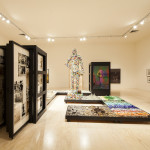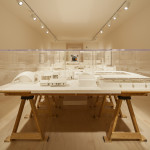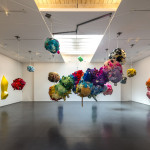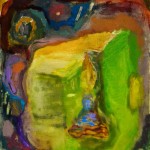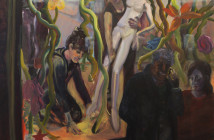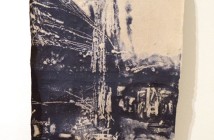My candle burns at both ends, it will not last the night. But ah my foes and oh my friends it burns a lovely light. Edna St. Vincent Millay
Seeing the Mike Kelley show at MoMA PS1 in Long Island City, I felt grateful for the gift of this amazing artist’s work, yet I was left befuddled by the experience and somewhat at odds with myself. Kelley’s work is touching because it deals with trauma, a subject most of us identify with, in varying degrees. And yet it left me feeling a bit blank. As someone who spent years making work about trauma and who knows a bit about it, I find myself yearning to now see the transcendence beyond it in art. I can identify with using art making as a vehicle to expose broken parts of the self, and that in doing that a therapeutic catharsis can take place. What I may have trouble with, however, is actively choosing again and again to identify with trauma.
 Mike Kelley. Deodorized Central Mass with Satellites. 1991/1999. Plush toys sewn over wood and wire frames with styrofoam packing material, nylon rope, pulleys, steel hardware and hanging plates, fiberglass, car paint, and disinfectant. Overall dimensions variable. (c) Estate of Mike Kelley. Images courtesy of Perry Rubenstein Gallery, Los Angeles. Photography: Joshua White/JWPictures.com.
Mike Kelley. Deodorized Central Mass with Satellites. 1991/1999. Plush toys sewn over wood and wire frames with styrofoam packing material, nylon rope, pulleys, steel hardware and hanging plates, fiberglass, car paint, and disinfectant. Overall dimensions variable. (c) Estate of Mike Kelley. Images courtesy of Perry Rubenstein Gallery, Los Angeles. Photography: Joshua White/JWPictures.com.Kelley spent his life's work focused on trauma in various forms, and eventually killed himself. I see this as proof that when you stare something in the face and try to dissect it enough it will consume you. Kelley was an expert in using art in a sort of science project "here is a display of my pain" kind of way. Much of the work’s power lies in Kelley’s knowledge of exploitation; the work feels much like a bodily display. While not always displaying images of the body, (though there are some beautiful cartoony, obscene drawings as you move through the show) we can sense the body. The placement of objects within Kelley’s signature "arenas" denotes a presence, a human touch. There is a psychic energy infused in the objects that becomes animated as we take it in. Perhaps the effect is now even more potent, as Kelly has passed on in a corporeal sense.
In a work such as Educational Complex (1995) the institution stands in as surrogate for the body. The piece is a long table upon which is displayed an architectural model of a large school. The precision and clean, white design is here and there disrupted by empty spots of nothingness. These orifices within the piece stand for places where abuse happened, places where someone was victimized, and trauma was endured. The power in the piece is the fullness taken on by absence. It seems to cry out to the viewer "See? Here are my holes. Here’s my proof. Here are all the places I’m empty from what happened to me." One is reminded of the doubting Thomas bit in the Bible in which Jesus must show the holes of crucifixion upon his body to the disciple in order to prove the validity of what he has experienced. This is all, however, done in a delicate, enclosed way. It’s not that the work is hermetic. Rather it’s so wide open that we are asked to connect to it through our involvement. The work penetrates us as we do the same to it, in this sense it is devoid of the hierarchical boundaries usually sensed in the traditional "viewer/piece" exchange. The democratization of energy exchange set up by these "arenas" could be viewed as more proof of Kelley’s distinct understanding of not only exploitation but also manipulation, the sort one only learns by being exploited and manipulated themselves.
Kelley harnesses this space opened up by the subconscious and we are asked to be active participants. A piece exemplifying this somewhat alchemical magic within the work is Lumenprole (1991). The piece is expansive: a large room is consumed by a knitted blanket, the pattern on which echoes the melancholy cheapness of 1970’s carpeting ,taking up a 20x20’ space. Huge bumps lie beneath the carpet, creating undulated protrusions throughout the floor. We don’t know what is underneath, yet the effect is a transmission of an anxious, haunted energy. The conversation opened up in this space would be one of repression taking up valuable space, of things beneath the surface becoming massively present in our existence. How sad that he didn't move beyond it, I thought. Personally I’ve suffered from post-traumatic stress syndrome for years, a condition wherein one’s brain and body are constantly reliving the traumatic event. My nervous system has been somewhat fried by this process and I’ve used a combination of therapy, yoga, and meditation to work through these issues.
Making art is therapeutic for the sensitive soul, no doubt, and it’s my belief that the most moving art comes from those who desperately need the outlet to communicate something. What gets left behind, though? Upon leaving the show my mind traipsed through territory of the cliché of the "depressed artist" type. The Jack Kerouac quote comes to mind: "the only people for me are the mad ones, the ones who are mad to live, mad to talk, mad to be saved, desirous of everything at the same time, the ones who never yawn or say a commonplace thing, but burn, burn, burn like fabulous yellow roman candles exploding like spiders across the stars." I thought about Van Gogh, Marilyn Monroe, Jimi Hendrix, Kurt Cobain and Jason Molina. One major association I made art historically was between the work of Ray Johnson, an artist of the Black Mountain School, whose suicide seemed to be pre-orchestrated as some sort of performance piece. Not to say that this was at all Kelley’s impetus for committing suicide, but to make the point that some creative people are so involved in their dimension of seeing that it becomes like a cage, or like walking through a carwash and being bombarded by slabs of rubber and getting soap in your eyes, when your intention is to experience life on a full level and to get through to the other side where there’s supposedly light. I began to connect with some anger towards this premise, in the notion that great artists must live with great pain. Surely enduring difficult life experiences and really allowing oneself to feel that discord can yield great art, but can't our lives still go on. Why the burn burn burn? What happens when we are finally burnt out? How tragic, I thought, that Kelley was one of these types that would not, or could not, see beyond pain. As I descended into the depths of the subway I shifted my thinking: maybe that was his art, his ultimate art. Maybe his gift to the world was to share his inability to transcend darkness. And that's kind of beautiful.
- Installation view of Mike Kelley at MoMA PS1, 2013. Photo: Matthew Septimus.
- Installation view of Mike Kelley at MoMA PS1, 2013. Photo: Matthew Septimus.
- Mike Kelley. Deodorized Central Mass with Satellites. 1991/1999. Plush toys sewn over wood and wire frames with styrofoam packing material, nylon rope, pulleys, steel hardware and hanging plates, fiberglass, car paint, and disinfectant. Overall dimensions variable. (c) Estate of Mike Kelley. Images courtesy of Perry Rubenstein Gallery, Los Angeles. Photography: Joshua White/JWPictures.com.
- Paulina Perlwitz, Slipping. 8×8. Watercolor on paper, 2013
- Paulina Perlwitz, Floating. 12 x 16. Oil on canvas, 2013.
Mike Kelley is on view at MoMA PS1 until February 2, 2014.



